- News
- Reviews
- Bikes
- Accessories
- Accessories - misc
- Computer mounts
- Bags
- Bar ends
- Bike bags & cases
- Bottle cages
- Bottles
- Cameras
- Car racks
- Child seats
- Computers
- Glasses
- GPS units
- Helmets
- Lights - front
- Lights - rear
- Lights - sets
- Locks
- Mirrors
- Mudguards
- Racks
- Pumps & CO2 inflators
- Puncture kits
- Reflectives
- Smart watches
- Stands and racks
- Trailers
- Clothing
- Components
- Bar tape & grips
- Bottom brackets
- Brake & gear cables
- Brake & STI levers
- Brake pads & spares
- Brakes
- Cassettes & freewheels
- Chains
- Chainsets & chainrings
- Derailleurs - front
- Derailleurs - rear
- Forks
- Gear levers & shifters
- Groupsets
- Handlebars & extensions
- Headsets
- Hubs
- Inner tubes
- Pedals
- Quick releases & skewers
- Saddles
- Seatposts
- Stems
- Wheels
- Tyres
- Health, fitness and nutrition
- Tools and workshop
- Miscellaneous
- Tubeless valves
- Buyers Guides
- Features
- Forum
- Recommends
- Podcast
TECH NEWS
Cannondale unveils all-new SuperSix Evo road bike + video
Cannondale has launched a brand new SuperSix Evo, with a complete redesign of the original model first launched in 2011. The Evo has been a very successful bike and won all sorts of races, from stage races to bunch sprints; it's really been a good all-rounder. The new Evo, though, is lighter, stiffer, more compliant and gets some aerodynamic upgrades, according to Cannondale's claims.
The SuperSix Evo has long been a firm road.cc favourite, and one that has aged extremely well. Replacing it was never going to be an easy task, but Cannondale reckons it has managed to improve it while still retaining the core appeal of the Evo.

The US company told us at the worldwide launch in Austria that it sought to create a more balanced bike, and has enhanced front-end compliance while giving it some aerodynamic features, all while not sacrificing the stiffness or weight - the Evo has long been one of the lightest bikes in its class, despite its age.

Cannondale says that other manufacturers have a narrow focus when designing a road bike, which might be stiffness, weight or aerodynamics. Cannondale has aimed to provide a “balance of power" with the new bike, that is stiffer for better power transfer in sprints, smoother for better handling in corners, and more aero for flat stages.
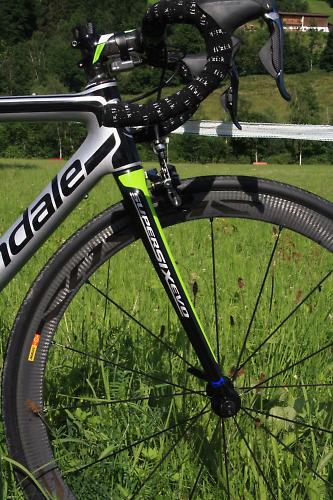
The new Evo is lighter
Weight has always been an Evo trump card. Cannondale has actually slightly increased the frame weight, up to 777g, but the overall system weight (frame, fork, headset, seatpost) has been reduced by 67g, which it reckons is lighter than the main rivals from brands such as Specialized and Trek - the SuperSix Evo is claimed to be 9g lighter than the Emonda system weight.
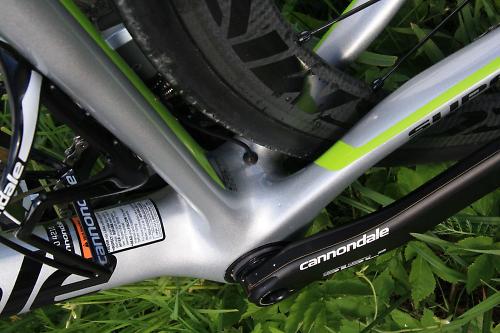
There’s an all-new Speed Save fork which has a one-piece design with an in-moulded carbon fibre crown that reduces the fork weight to 280g, from the 320g previously. The fork blades have a new profile aimed at improving front-end compliance, which Cannondale claims is increased by 21%.

Also saving weight is the 25.4mm seatpost, borrowed from the Synapse, which reduces weight over the previous 27.2mm post. The skinnier post also provides more deflection for a smoother ride, with a claimed 36% more seated comfort.
The new Evo is more aero
Aerodynamics is increasingly informing every aspect of road bike and equipment design, and the Evo is no exception, but Cannondale has clearly been restrained, resisting the temptation to make it a true aero road bike.

So it's more aero, but it's very subtle. All the main frame tubes have a new Truncated Aero Profile (TAP). The position of the seatpost water bottle has been lowered, a move that contributes to a 6 watt drag reduction at 40km compared with the old Evo. The frontal surface area has been reduced with a narrower hour glass head tube.
The new Evo is stiffer and more compliant
Cannondale uses a similar BallisTec carbon fibre construction as in the previous SuperSix Evo, and uses a base structure of high strength fibres and high impact resins on the new Evo to provide the desired balance of weight, stiffness and compliance.

Along with the new full carbon fibre fork to reduce the frameset weight, Cannondale has developed a new one-piece rear stay assembly, with asymmetrically oversized chainstays and a new wider seat tube, made possible because of the use of a wider BB30a 73mm bottom bracket shell, as used on the Synapse.

Cannondale has also revised the layup of the carbon fibre around the bottom bracket, and created a leaf spring effect that provides more vertical deflection. Cannondale claims the bottom bracket is now 11% stiffer. The new head tube provides a 12% stiffness increase as well. Cannondale reckons this is optimum stiffness, any more and it’s too stiff and chattery and will compromise handling.
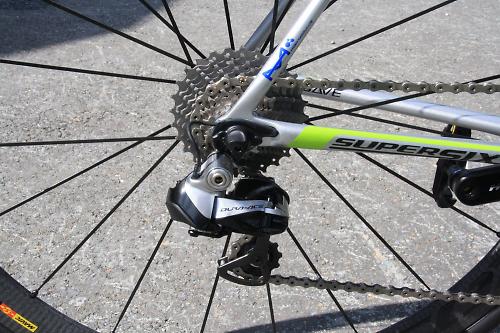
To avoid an increase in the Q-factor (distance between the pedals), Cannondale has developed its own Si chainset to have a narrower design to maintain the same Q-factor as the original bike.
Cannondale continues to use a size-specific construction with the new frame, as it did with the previous model (it just didn’t shout about it loudly enough) that sees tube shapes and wall thicknesses modified according to the frame size.
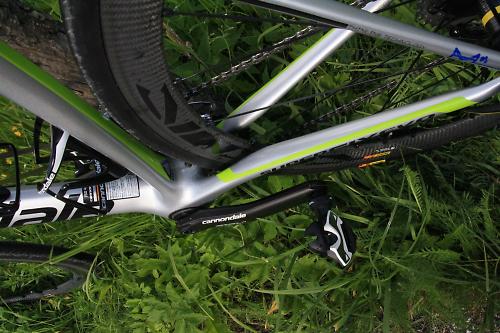
Oh and one change that will please a lot of people is the improved tyre clearance: the new Evo accepts 28mm tyres.
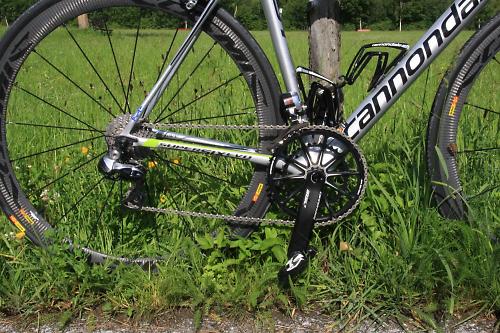
Five model range
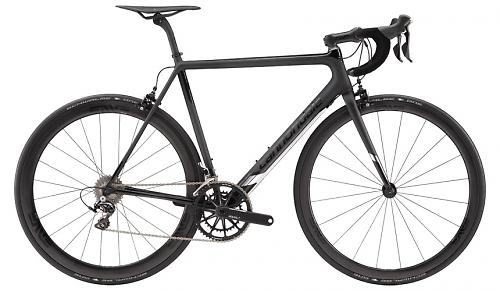
The new SuperSix Evo will be available in five builds. Sitting at the top of the range is the Black Inc model with a Dura-Ace mechanical and Enve 45 rims on Chris King hubs build. It’ll be light, very light, Cannondale claiming 5.8kg (12.79lb). No UK price yet, but in dollars it’s a mighty $12,790.
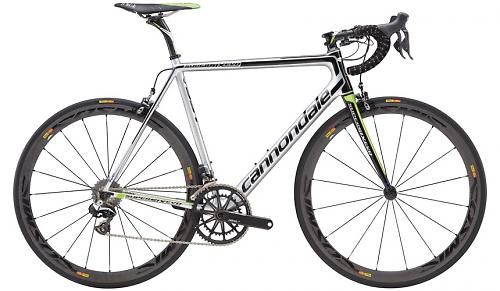
The SuperSix Evo Hi-Mod Team comes with Shimano Dura-Ace Di2 and Mavic Cosmic Pro Carbon wheels and will weigh a claimed 6.3kg (12.89lb) and costs $10,660.

The SuperSix Evo Hi-Mod Dura-Ace 1 is equipped with Shimano Dura-Ace 9000 mechanical and Mavic Ksyrium Pro wheels and Hollowgram SiSL2 chainset. It weighs a claimed 6.58kg (14.51lb) and costs $7,990.
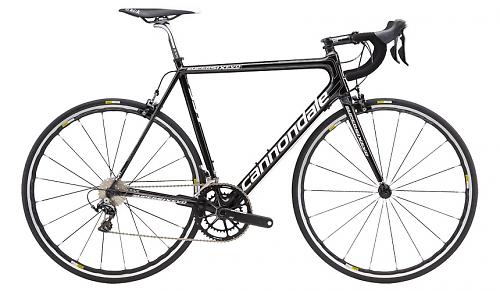
The SuperSix Evo Hi-Mod Dura-Ace 2 gets the same Dura-Ace 9000 mechanical but downgrades the wheels to Mavic Ksyrium Elites with Cannondale’s Hollowgram Si chainset. It weighs in at 6.58kg (14.51lb) and costs $5,330.

Finally, the SuperSix Evo Ultegra gets a Shimano Ultegra 6800 groupset with Mavic Ksyrium wheels and weighs 6.9kg (15.21lb) with a $4,260 price tag.
All models are expected to be available in September. We’ll update with UK prices once we get them.
We'll have more details, prices and first ride impressions on the new SuperSix Evo tomorrow, so be sure to tune back in then for more on Cannondale's latest bike.
David worked on the road.cc tech team from 2012-2020. Previously he was editor of Bikemagic.com and before that staff writer at RCUK. He's a seasoned cyclist of all disciplines, from road to mountain biking, touring to cyclo-cross, he only wishes he had time to ride them all. He's mildly competitive, though he'll never admit it, and is a frequent road racer but is too lazy to do really well. He currently resides in the Cotswolds, and you can now find him over on his own YouTube channel David Arthur - Just Ride Bikes.
Latest Comments
- hawkinspeter 7 sec ago
It's a veritable war on parkers, don't you know! https://www.bristolpost.co.uk/news/bristol-news/cameras-plan-catch-parents-parking-9764409
- Rome73 5 min 34 sec ago
Yes, that's right. They won't go into estates because it's almost impossible to pinpoint the exact address and would require too much surveillance...
- Keesvant 8 min 5 sec ago
I think it's to big.. Roam is about the bright seize for a bike computer..
- brooksby 1 hour 8 min ago
If you take a cursory glance around the site, Blackbirds posts almost always tend toward the sarcastic...
- hmas1974 4 hours 21 min ago
Irrespective of the fact that bikes don't have licence plates or other means of identification, your approach won't work. Richmond Park isn't flat...
- wtjs 9 hours 7 min ago
Yes! Nineteen Eighty-Four is where the police learn to construct their publicity releases and other statements: our thoughts and prayers are with.....
- mdavidford 10 hours 9 min ago
Go up or down hill.
- Zebra 10 hours 19 min ago
Personally, I thought that the Astana Willier was the best looking bike in the peleton for the past couple of years.
- Prosper0 10 hours 57 min ago
Looking forward to picking the shoes up on Sports Pursuit soon.















































Add new comment
37 comments
Takes 28mm tyres. But can you take the wheel out and put it in again without deflating the tyre (like I have to do with 25mm tyres D:)
D:)
WTF is that chainset.
Looks like a fairly bog standard Cannondale Si/SiSL chainset.
I wasn't expecting anything drastic but I know what you mean. However, I think I prefer it that a company is making small thought out adjustments and really fine tuning something that's already good rather than bringing out a new version of something that doesn't resemble the previous model very much.
As a Cannondale owner, and someone who has Cannondale bikes all over my 'want list' ........
For all the good will in the world, this does does look like Cannondale taking the old bike, giving it a new paint job, and then announcing "Look, New Bike, and its X % stiffer! Y % more complaint Z % more aero U% more comfort."
It almost seems a pastiche of other 'new bike press releases'.
Perhaps I should not be so negative. Given how much I love the traditional look of the old Evo, a 'slightly improved' new model which looks much the same is probably better to cope with than if Canondale hod gone the full aero on this...
I guess looking at the bike from a distance it looks the same. But almost every tube shape is new and looks even more refined than the current EVO, especially around the BB juntion. I really like the look of the EVO in general, glad they did not change it, still the most classic looking carbon race bike.
I'm sure Cannondale will release a full aero bike in the future, since they hired Damon Rinard. That bike is probably for 2017/18.
I can assure you the bike is all new, when you see it in the flesh you will see that even though the silhouettes are similar, nothing on the new bike is shared with the old one. It's like a 911, an evolution in performance whilst keeping what worked in the predecessor.
It was a real conundrum updating the Evo, there really was't anything wrong with the old one except it was....old. Therefore sales slow down as 'the market' expects a new one. The trick is figuring out what people want verses what you think as a manufacturer is best.
In this case we think this new bike is the best all around race bike out there. If you go too aero (which is the current trend) then you just lose so much comfort which is one of the Evo's main benefits, you can get off it after 100 miles and not feel battered to death,
Thanks for the comments, good to read the feedback and I'm sure a disc version might appear later in the year when the UCI are ready to do some test races.
Pages